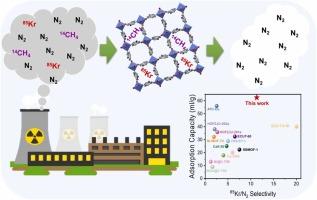An efficient Ni-based adsorbent for selective removal of 85Kr and 14CH4 in radioactive contaminants from nuclear process off-gas stream
IF 12.2
1区 环境科学与生态学
Q1 ENGINEERING, ENVIRONMENTAL
引用次数: 0
Abstract
Efficient adsorbents for radioactive gas treatment in nuclear energy cycle is crucial for eliminating negative environmental impacts caused by wide nuclear applications. A Ni-based MOF material called JUC-86(Ni) which is based on 1-H-benzimidazole-5-carboxylic acid (HBIC) linker was synthesized for adsorbing the 85Kr, 14CH4 from off-gas stream. It was disclosed that there is a suitable pore environment for 85Kr and 14CH4 preferred adsorption in JUC-86 and the adsorption capacity could even reach 2.79 mmol/g (85Kr) and 2.54 mmol/g (14CH4) which are almost higher than all the adsorbents. The 85Kr/N2 and 14CH4/N2 IAST selectivities of the resulting sample are satisfactory (11.63 and 9.43) and well matched with the breakthrough experiments where the breakthrough times of 85Kr and 14CH4 are much longer than N2. What’s more, the adsorption heats of 85Kr and 14CH4 are less than 30 kJ/mol which indicated a stronger affinity than N2 and a low-energy regeneration. As simulation results showed that the adsorption distribution follows a-spiral-pattern which could be attributed to the N atom in the C=N, this is also the dominant factor of the 85Kr and 14CH4 preferable adsorption.

用于选择性去除核工艺废气流中放射性污染物 85Kr 和 14CH4 的高效镍基吸附剂
用于核能循环中放射性气体处理的高效吸附剂对于消除广泛核能应用所造成的负面环境影响至关重要。研究人员合成了一种名为 JUC-86(Ni)的镍基 MOF 材料,该材料以 1-H-苯并咪唑-5-羧酸(HBIC)连接体为基础,用于吸附废气流中的 85Kr、14CH4。结果表明,JUC-86 中存在适合吸附 85Kr 和 14CH4 的孔隙环境,吸附容量甚至可以达到 2.79 mmol/g(85Kr)和 2.54 mmol/g(14CH4),几乎高于所有吸附剂。所得样品的 85Kr/N2 和 14CH4/N2 IAST 选择性令人满意(分别为 11.63 和 9.43),与突破实验结果非常吻合,其中 85Kr 和 14CH4 的突破时间远远长于 N2。此外,85Kr 和 14CH4 的吸附热均小于 30 kJ/mol,这表明它们的亲和力比 N2 强,再生能量低。模拟结果表明,吸附分布呈螺旋状,这可能归因于 C=N 中的 N 原子,这也是 85Kr 和 14CH4 优于 N2 吸附的主要因素。
本文章由计算机程序翻译,如有差异,请以英文原文为准。
求助全文
约1分钟内获得全文
求助全文
来源期刊

Journal of Hazardous Materials
工程技术-工程:环境
CiteScore
25.40
自引率
5.90%
发文量
3059
审稿时长
58 days
期刊介绍:
The Journal of Hazardous Materials serves as a global platform for promoting cutting-edge research in the field of Environmental Science and Engineering. Our publication features a wide range of articles, including full-length research papers, review articles, and perspectives, with the aim of enhancing our understanding of the dangers and risks associated with various materials concerning public health and the environment. It is important to note that the term "environmental contaminants" refers specifically to substances that pose hazardous effects through contamination, while excluding those that do not have such impacts on the environment or human health. Moreover, we emphasize the distinction between wastes and hazardous materials in order to provide further clarity on the scope of the journal. We have a keen interest in exploring specific compounds and microbial agents that have adverse effects on the environment.
 求助内容:
求助内容: 应助结果提醒方式:
应助结果提醒方式:


